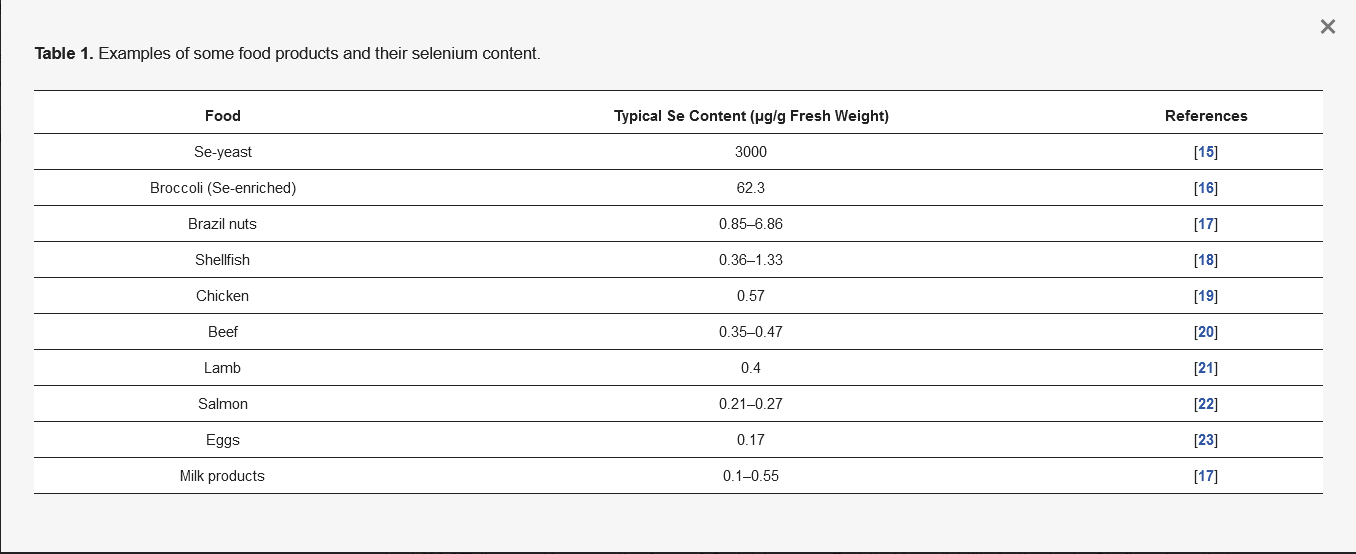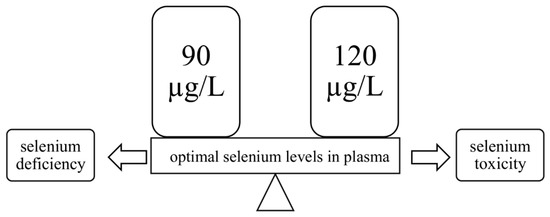Se This taken with the diet in the form of organic (SeMet and Sec) and inorganic compounds (selenites, selenides). The absorpentry answers the question of these compounds mostly occurs in the duodenum and cecum, and their absorption mechanism depends on the chemical form of ingested Se. Inorganic compounds are absorbed by simple diffusion (selenites) or by secondary active transport, the so-called cotransport (selenides). In turn, organic compounds (SeMet, Sec, methylselenocysteine (MSC)) are absorbed by active transport in the same way as amino acidswhy selenium is such an important trace element in the human diet.
- Selenium
- micronutrients
1. Selenium in the Diet
Selenium (Se) occurs as a trace element in the human body, performing a number of important biological functions, and is essential for life and health [1]. The main natural source of Se is food, but Se content varies. This is determined by the geographical location, soil quality in terms of Se concentration, and how much it is accumulated in plants. The climate and the way the food is cultivated and bred, and how we prepare it for consumption, are also important factors [2][3]. The richest sources of Se in the diet are Se-yeast (Se-enriched yeast), nuts, cereals, organ meats, fish, and seafood [4]. Brazil nuts (Bertholletia excelsa, family Lecythidaceae), a plant from the Amazon, have the highest known Se content among non-Se-enriched food [5].
Table 1. Examples of some food products and their selenium content
| Food | Typical Se Content (µg/g Fresh Weight) | References |
|---|---|---|
| Se-yeast | 3000 | [6] |
| Broccoli (Se-enriched) | 62.3 | [7] |
| Brazil nuts | 0.85–6.86 | [8] |
| Shellfish | 0.36–1.33 | [9] |
| Chicken | 0.57 | [10] |
| Beef | 0.35–0.47 | [11] |
| Lamb | 0.4 | [12] |
| Salmon | 0.21–0.27 | [13] |
| Eggs | 0.17 | [14] |
| Milk products | 0.1–0.55 | [8] |

This microelement can exist in food in both chemical forms—as inorganic and organic compounds [15]. Mostly, Se is found in the form of organic compounds as selenomethionine (SeMet) and selenocysteine (Sec) in plant [16] and animal [17][18] tissues. However, the form of Se intake can affect its bioavailability in the body. Studies show that organic Se (e.g., SeMet) is more bioavailable than its inorganic compounds such as selenates or selenites [18][19][20]. Interestingly, the bioavailability of this element in the body is also modified by race. Richie et al. observed that in whites it is significantly higher than in blacks [21]. Nevertheless, the most important thing is a healthy and balanced diet that contains all the nutrients at the right levels. As far as Se and its recommended daily dose are concerned, it depends on the local content of this element in the cropland, as this affects its content in the food [22][23][24]. According to World Health Organization (WHO) standards, the recommended daily dose of Se for adults is 55 µg/day [4][25][26], while the maximum tolerable adult intake without side effects is set at 400 µg/day [4]. Of course, the requirement for Se depends on age and gender [4], as shown in
| Age Group | Male (µg/d) | Female (µg/d) | Pregnancy (µg/d) | Lactation (µg/d) |
|---|---|---|---|---|
| Birth to 6 mths | 15 * | 15 * | ||
| 7 to 12 mths | 20 * | 20 * | ||
| 9 to 13 yrs | 40 | 40 | ||
| 14 to 18 yrs | 55 | 55 | 60 | 70 |
| 19 to 30 yrs | 55 | 55 | 60 | 70 |
| 31 to 50 yrs | 55 | 55 | 60 | 70 |
| 50 to 71 yrs | 55 | 55 | ||
| Above 71 yrs | 55 | 55 |


